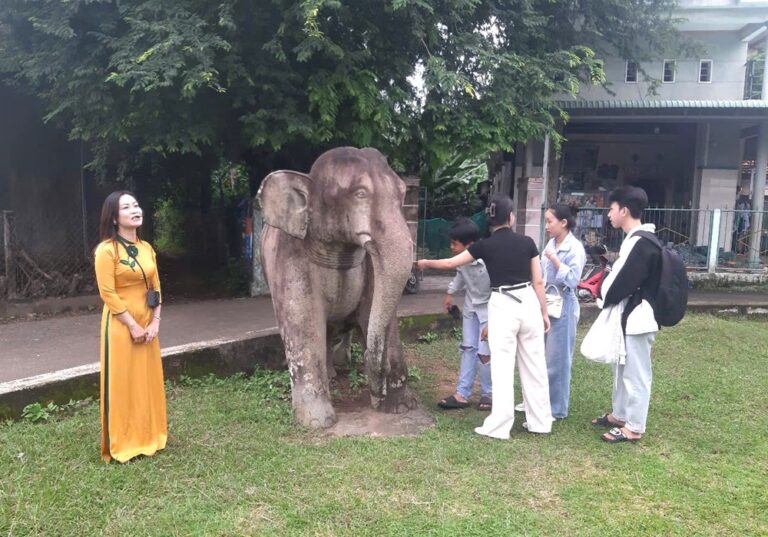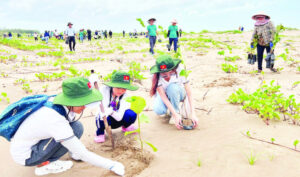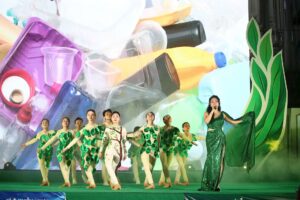With a clot of colored sticky rice dough, a small comb and bamboo sticks, craftsmen in Xuan La Village, Phuong Duc Commune in Hanoi's Phu Xuyen District can make To He toys to depict a vivid world. As a rustic and unique traditional toy, To He remains a sweet childhood memory of many Vietnamese people.
Origins
Entering Xuan La Village on the last days of the year, I was warmly welcomed by a happy smile of Nguyen Van Giat, one of the village's famous To He makers. The thin and long alleys retain the sweet smell of sticky rice. However, a strange silence had fallen on the area, banishing any everyday concern . "Everybody is preparing flour to make To He tomorrow," said Giat, adding that the Spring is the most busy period for the village. During the seasons craftsmen often go about to make and sell To He toys at festivals, events and amusement places nationwide.
Giat quickly kneaded dough while telling me about the history of To He. Nobody, even the elderly in the village, know exactly when Xuan La started this traditional handicraft. It is said that the craft appeared in Xuan La Village approximately 300 years ago. Through the vicissitudes of the history, To He makingcontinues to be handed down from generation to generation. The funny name "To He" originates from the sound "To Te" of malt whistles - one the oldest forms of To He.
In the old days, local craftsmen kneaded sticky rice dough into birds, storks and bitterns, and then steamed and colored them before selling on the local market. Nowadays, To He is made to depict heroes and ordinary people of daily life, symbolic animals like dragon, phoenix and buffalos, flowers and elements from historic and fairy tales. According to Giat, making To He toys now requires greater skills, more meticulous characters, and even higher technology. The craftsmen now use cooked dough instead of the raw paste as in the past, in order to create a many varieties of To He as possible to entertain customers, especially children, Giat added.
Materials to make To He are easily available throughout Vietnam. They include ordinary and sticky rice flour and different colourings. The colourings such as black, green, yellow, violet, pink, and red of To He come from edible plants, especially fruits and vegetables. Therefore, children can eat the To He after playing with them.
The craftsmen firstly grind ordinary and glutinous rice into a fine powder, then pour water into the mixture until the powder becomes a sticky lump and cook or steam it. The success in making To He toys lies in the preparation for the dough, the quality of rice, weather, and experience of the makers.
With a clot of colored sticky rice dough, a small comb and bamboo sticks, craftsmen in Xuan La Village can depict a vivid world of To He toys. To He is also educative. Through sculptured figurines, children are able to imagine heroes, famous people, kings, mandarins, and both history and folk tales.
There is no common formula or pattern for making To He. The craft, however, requires imagination, creativity, great dexterity, and patience.
To He's vitality
"This job has it's ups and downs," said Giat, adding that his family had been making To He for more than 60 years, with four generations of his family, including his son taking part. Many families in Xuan La have claim five to seven generations have continued this job. Sometimes, the craft appeared on the verge of oblivion because it could not provide enough money for the local people to live. However, great passion, conscientiousness and cultural tradition have helped them overcome their difficulties to preserve their craft village.
As a young craftsman, Nguyen Van Thanh - the chairman of the To He Craft Village Club said: "for every Xuan La local, making To He is as necessary as breathing." In response to my question about the competitiveness of To He compared with modern toys that are overwhelming the domestic market, Thanh affirmed that To He still remains very attractive to local children due to its diverse colors and types. In today's modern society, people often turn to respecting traditional values, thus contributing to the development of folk toys such as To He, Thanh added.
With regards to its long-term development, Thanh said that his club was planning to combine craft village development with tourism. Firstly, the club will soon complete a collection of old artifacts and build a To He exhibition center in order to introduce To He's history and products to tourists.
When Phuong Duc Commune completes its new rural construction program, the club will promote a program on the development of craft village tourism.
Xuan La Village is expected to make every effort to preserve the craft, and continue to bring joy and happiness tofuture generations of children./.















